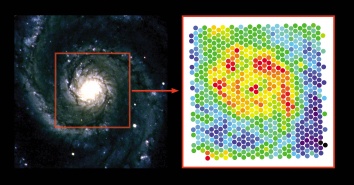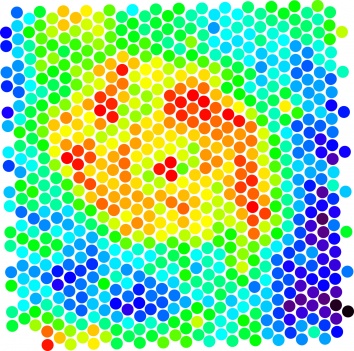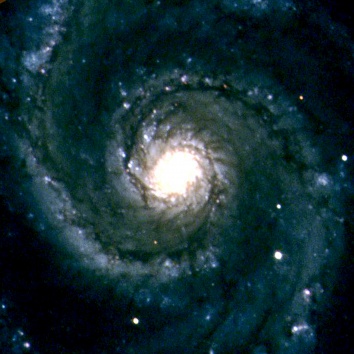New McDonald Observatory Instrument Revolutionizes Galaxy Studies
9 July 2009
SARTEANO, ITALY —University of Texas at Austin graduate student Guillermo A. Blanc is talking dissection. But he’s not a biologist — he’s an astronomer. Blanc is using a new instrument at the university’s McDonald Observatory to dissect nearby galaxies to learn how stars form, and in the process, generating a flood of new information that will benefit other scientists’ work. Blanc is presenting his first results this week at an international conference called “SFR@50: Filling the Cosmos with Stars” in Sarteano, Italy.
The conference celebrates the 50th anniversary of a landmark study of the star formation rate (SFR) in galaxies. Blanc’s research will set a new landmark in this arena, with a new way to study star formation in nearby galaxies using the best instrument in the world for these kind of studies.
Blanc is mapping star formation in 30 nearby spiral galaxies in amazing detail using the VIRUS-P instrument on McDonald Observatory’s 2.7-meter Harlan J. Smith Telescope. His project is called VENGA, the VIRUS-P Exploration of Nearby Galaxies.
“We are going to dissect these galaxies in every possible way,” he says. “The tendency for galaxy studies today is to look at galaxies farther away, and farther back in time. But in order to understand those, you really need to first understand galaxies in detail. The best way to do that is to look at nearby galaxies. It allows you to interpret the data on distant galaxies.”
His first VENGA target is the famous Whirlpool Galaxy, and he’s presenting those results in Italy this week. The study is helping to determine the drivers for star formation in galaxies. Previous studies disagreed about the role played by molecular gas at setting the rate at which stars form. Blanc’s study, done in collaboration with Texas astronomers Amanda Heiderman, Karl Gebhardt, Neal Evans, and Joshua Adams, shows that the amount of molecular gas is the key factor determining how many stars are formed.
“We confirm that the star formation rate correlates very well with the amount of molecular gas present in different regions inside galaxies. These two quantities are expected to be correlated since this is gas in giant molecular clouds, which are the birth places of stars. These new type of observations allow us not only to observe this correlation, but also to measure precisely how these two quantities relate to each other,” he says.
He also found that the efficiency of star formation in this galaxy is very low — only one percent of the available gas is transformed into stars in a characteristic time. Additionally, Blanc’s studies reveal that for a given amount of gas, the rate of star formation can vary by a factor of three, meaning there might be other important drivers of star formation. Blanc plans to investigate these in future studies.
It’s the special design of the VIRUS-P instrument that makes Blanc’s studies of star formation new and exciting. Like all spectrographs, VIRUS-P takes the light from astronomical objects and breaks it down into its component wavelengths, resulting in an information-rich spectrum that astronomers can decode to learn an astronomical object’s motion, composition, temperature, and more.
But this spectrograph is different. Instead of taking the spectrum of a single point on the sky, it takes lots of spectra of lots of areas at one time. It’s what is called an “integral field unit” (IFU) spectrograph. VIRUS-P has the largest field of view of any IFU spectrograph in the world (2.9 square arcminutes), several times larger than the previous record holder.
For each of its 30 galaxies, VENGA will obtain spectra at every point in the galaxy, from the center to the most outlying regions of the galactic disk. With VIRUS-P’s array of 246 optical fibers, the speed and direction of motion of both stars and gas at 246 different points inside the galaxy, as well as many other quantities like the star formation rate, the amount of light extinction due to dust, and the chemical composition of gas and stars, can be measured simultaneously in a single telescope pointing.
The instrument is “ideal for studying nearby galaxies,” Blanc says. “These galaxies are so nearby they are huge on the sky, so this is the most efficient instrument there is to study them, due to its large fibers and large field of view.”
Star formation rates have been studied with spectroscopy before, Blanc says, but “but it wasn’t possible to do it throughout a whole galaxy, much less 30 galaxies, in an efficient way.”
When the survey is completed, the VENGA team will have mapped 30 nearby spiral galaxies with a wide range of shapes. Some have large central bulges of stars, others almost none. Some have a bar running through the center; others don’t. The galaxies also have different levels of star formation activity. All of this data will be of interest to many different astronomers, and they plan to make it freely available.
“When you point a spectrograph at a galaxy and you get every region of the galaxy and at a large wavelength range, you get a lot of information and it can be used for a lot of different science projects,” Blanc says.
The VENGA team is composed of a large group of astronomers from The University of Texas at Austin and Germany’s Max Planck Institute for Extraterrestrial Physics. The data will help in astronomers Niv Drory, Maximilian Fabricius, and David Fisher's studies of the different types of galactic bulges and the evolutionary paths galaxies took to form them. It will also be of great use to Texas astronomers Shardha Jogee, Irina Marinova, and Tim Weinzirl in their studies of the chemical compositions of galaxies’ bulges versus that of their disks, and the role that galactic bars have in driving gas toward the centers of galaxies. These latter studies aim to determine the degree to which internal processes and galactic mergers are responsible for building up a galaxy’s central bulge. The VENGA data also will allow Dutch astronomer Remco van den Bosch to study the structure of the dark matter halos in which these galaxies are thought to be embedded.
VIRUS-P is the prototype for a forthcoming larger spectrograph that will be built at The University of Texas to carry out the Hobby-Eberly Telescope Dark Energy Experiment. This larger spectrograph will contain 150 copies of the prototype, each with its 246 optical fibers, for a total of 36,900 optical fibers taking spectra across the sky simultaneously. The instrument’s name, VIRUS, comes from the fact that it contains multiple copies of a single instrument: the Visible Integral-field Replicable Unit Spectrograph.
— END —
Contacts:
Guillermo Blanc, The University of Texas at Austin (512-471-3447)
Rebecca Johnson, Press Officer, UT-Austin Astronomy Program (512-475-6763)








